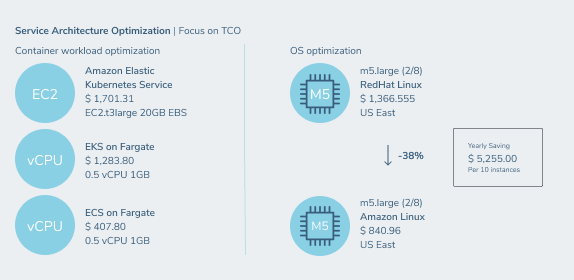In our previous blog we talked about the Service Characteristics. Let’s move on to Perspective 4: AWS Service Architecture Optimization. Are you using the most appropriate and most efficient service for your use case? In this blog we will show you an overview which describes a realistic container workload.
A realistic container workload
In the left part of the overview down below we describe a realistic container workload. The first container is running on Amazon Kubernetes on EC2. Check out the initial cost level of $1.701,31.
If you were to migrate this container workload to an alternative container service model, in this example from Amazon Fargate (EKS on Fargate), it significantly decreases the cost level by more than 400 dollars. Continuing, if you don’t specifically require Kubernetes, you can look at the native container service of AWS (Amazon ECS on Fargate). It decreases the costs again with almost an additional 900 dollars.
On the right side of the overview, we present a similar example with respect to the OS levels that are available to AWS customers. If you are working with RedHat, it saves almost 40% of your EC2 spend for the same instance performance if you were to transition to Amazon Linux. This is effectively the license cost of RedHat, which is not applicable in Amazon Linux. This makes paying attention to you OS of choice an important area to look at.

A few other quick tips
A few other quick tips to explore within Service Architecture Optimization:
- To reduce your networking cost, look at VPC endpoints to make more efficient use of your traffic.
- Consider Amazon Glacier for archive storage instead of S3.
- Look at optimizing your network routing.
- Code/Query optimization: this covers all kinds of areas that are affecting your application architecture but that are also open to significant savings.
How to optimize your AWS costs even further
Do you have any further questions around AWS Service Architecture Optimization? Feel free to contact us. Ready to learn more about the five perspectives? Read up on Perspective 5: Service Pattern Analysis in the next blog. Need this knowledge on the go, or do you want to share it with a colleagues? Download the full original whitepaper here: ‘AWS Cost Optimization in Five Perspectives’.




